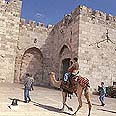
Jaffa Gate
צילום: יעקב סער, לע"מ
In and around Jaffa Gate
The Muslim Quarter is the one with the domes and antennas, the Jewish one is the whitest, the Christian one is characterized by its red roofs and the Armenian quarter is hard to discern. A view of the Old City from a Jerusalem rooftop, engineers whose luck ran out, an ancient hostel, a church with Jewish symbols and a small but significant arrow, all part of a short but jam full tour from Jaffa Gate to the Western Wall. Part one of a two-part series
We begin our tour this time at a tree and two graves hidden behind an iron fence. Omar Al Khatav Square is located near Jaffa Gate (inside the wall), and the concealed graves can be seen if you look to the left, with Jaffa Gate at your back.
The legends about their identity abound, but the most common one says they are the burial site of two engineers who built the walls of the city in the 16th century. Another story is that because Mt. Zion, a holy site for the Moslems as well as Jews, was not included within the walls Sultan Suleiman the Magnificent had the two engineers executed and buried near the gate.
Another account of the unfortunate incident is that the sultan wanted to prevent them from building walls more impressive than those of Jerusalem. Yet a third version, the one I like the most, is that the sultan made a calculation that it was cheaper to pay an executioner for two minutes of work than to pay two engineers for four years of labor.
Into the city
We continue into the Old City with David’s Citadel to our right. After about 10 meters we can see the Imperial Hotel with its elaborate façade to our left. The hotel was built in 1889 and was considered one of most elegant of its time, apparently because of the hot water it provided for guests.
The edifice incorporates a series of passageways and halls, each one featuring a gate to protect the hotel’s guests.
The hotel has a European inner courtyard with Roman columns, and from the inside one can also admire the decorative ceilings. Ever since the Greek Patriarch sold it, the hotel has been managed by the Dejani family, a veteran Jerusalem dynasty.
To the left of Davis’s Citadel is a sign carved in the building’s stone saying “Austrian Postal House”. This is one of the first post offices in the Middle East, inaugurated in 1858 under the aegis of the Austro-Hungarian Empire that supported the Turks.
The branch was closed with the outbreak of World War I, following which the British consolidated all postal activity into a central branch on Jaffa Road. In 1965 the building was purchased and renovated by the Franciscan Monastic Order, and since then it has served as a Christian information Center.
The Protestant Quarter
To our right, directly across from the entrance to the citadel, is a branch of the Israeli Postal Authority, and adjacent to it is a black metal gate through which one enters the courtyard of the Church of Emmanuel, the Community of the Messiah.
This site contains a number of historic, artistic and cultural treasures connected with the city. In 1842 Protestant missionaries laid the cornerstone for what was called “The Protestant Quarter”, after receiving permission from the Ottomans to build the first church in Jerusalem.
Since crusader times it had been forbidden to ring church bells (and also to blow the shofar) in Jerusalem. The bell in the courtyard of the quarter was brought here in 1854, after receiving unprecedented permission to ring it – as a result of cooperation between the British and the Turks during the Crimean War.
Across from the church is the dining hall of a guest house featuring an enormous 19th century oil painting depicting the old city from the Mount of Olives. Perceptive observers will note that the painting is not quite accurate. This is because the painting was actually made in Europe, not in the holy city itself.
In a nearby chamber are a number of models of Jerusalem, some of which were constructed by the legendary Jerusalem researcher, Konrad Schick, who planned the Mea Shearim neighborhood, uncovered the inscription of the Shiloah in the water tunnel of the City of David and did many other things in and for the city of Jerusalem.
Since the aim of the church was to convince Jews to pray there, it has no statues or paintings. Its altar is engraved with the Ten Commandments and other Hebrew inscriptions, and on the Jewish holiday of Sukkot a sukka is constructed here. Today the church is part of the Anglican Church and it has a very pleasant guest house that I can personally recommend.










